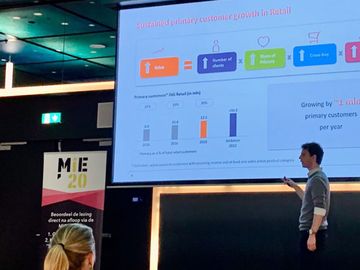
Interview Daniel Bäumer (Vodafone DE): “Digital transformation must happen at customer speed”
Vodafone.de was favorited most in the latest WUA! customer experience research on the orientation on a mobile phone and plan. Daniel Bäumer is Head of Digital at Vodafone Germany. In this interview, a conversation about digital transformation, omnichannel, agile working, service as a product, C-level support for digital and personalization in the digital landscape.
Congratulations, Daniel Bäumer. With vodafone.de, you’re the winner of this WUA! digital customer experience research. How important is it for you to be the best?
“It’s actually really important. Our key target is to provide an outstanding customer experience. But also and of course: getting the commercial benefits from that. We are convinced we will not get these benefits and won’t do a lot of sales or provide excellent service without addressing customer needs and providing a great customer experience.
“This award is a great confirmation that the team does an excellent job from probably one of the most mature digital experience benchmarking companies that I know about. But we also know we need to do more. The digital arena is really transparent. Competitors see what we do, and we see what our competitors are doing. But also our customers see everything we do and what happens elsewhere in digital. Hence, customer expectations are rising and we need to be really focussed to stay at the top.”
Vodafone.de is taking the lead in the ranking of this research. Can you elaborate on your tactics and digital approach: which indicators for success can you address?
“The most important aspect of our strategy is that we look at the digital journeys from a customer perspective. But we also take a step back and look at the customer journey across all channels. We defined the Vodafone experience that we wanted customers to have across all channels and we did this upfront. We defined how a customer should perceive Vodafone, our offers and our services. And then we broke it down into all channels. So we defined the customer journey, set the standards, and only when this was done, we went implementing for digital in an agile way.
“We need to keep track on customer’s expectations and we know these are changing faster and faster today. There’s a nice saying: Digital transformation must happen at customer speed. You cannot wait a year before an application release goes live. You need to do changes on a daily and weekly basis. That is why we already started to transform the business. But we also transformed our IT-infrastructure into a layered architecture. We decoupled the front-end that the customer is using in a browser from the applications underneath, utilizing API’s. This enables us to change the flows and the customer experience almost on a weekly basis.”
What role does customer feedback and customer research play in your day-to-day business?
“A very important role. We take customer feedback from various sources. We do benchmarking, like the exercise you did in your research. But we also have Vodafone internal benchmarking exercises, often they are co-ordinated with Vodafone Group and are done across our markets. Maybe the most important source for us, is instant customer feedback we get from surveys. We use an NPS-surveytool called Heartbeat. With this tool, we ask our customers in various channels for feedback on their touchpoint experience but also, depending on the channel, we ask them for more details.
“We receive a few hundred of these surveys for online every week, on all six journeys. These journeys include ‘buy a phone’, ‘renewal’, ‘top-up’, ‘help & support’, ‘manage account’ and ‘view bill’. We are able to see this feedback on a daily basis and our channel manager is taking a look at the customer responses instantly and uses this input for the improvement and development of our online journeys. Heartbeat is customer feedback in your pocket! The feedback is coming at us instantly, but of course we do additional analysis, report and cluster feedback based on semantics like sentiments to identify pattern and areas of improvement.
“Sometimes, at some specific topics we want to have even more insights about what our customers are thinking. We get help from our colleagues at the customer contact center: whenever a customer comes in with a specific question in an area we want more insights from, they will capture additional insights from the customer. We call this: WOCAS (What Our Customers Are Saying).
“The biggest value I see comes from the verbatims. The touchpoint NPS is mainly a number showing if we move in the right direction. Why does a customer grant us a 10? Or a 0? I’m interested in the clustering of the verbatims: finding common schemes. The feedback online is very often that people cannot find what they are looking for, or that a tool is too complex. But sometimes, the feedback is very specific: ‘I didn’t find X, Y or Z.’ And that really gives us hints on where to improve and make a difference for our customers. I want to know WHY people cannot login, for example. A lot of customers are willing to give us detailed feedback which is fantastic!”
Why is that, do you think? Because you made giving feedback an easy thing to do for them?
“Yes, it’s easy. You select an NPS value and you type a few sentences about your reasons why.. I would say this is the most important type of customer feedback for us, but what it doesn’t give you, is a comparison of your performance compared to the competition. That is what benchmarks are great for. Apart from our own research, we look at the websites of our competitors, we also use their products, we use their tools and their processes to see what we can learn. A focus on customer experience also requires us to understand the market.”
What is your biggest digital challenge?
“In terms of reaching our commercial KPI’s, the hardest thing is that it’s not only the online experience that helps reaching those targets. It must be a combination of the right proposition and how we define a product for digital. We want all Vodafone propositions to be ‘online ready’ or even better: ‘online first’. So that means, propositions should be easy to use, not too complex, easy to understand, and competitive from a price-value perspective. And the same goes for the purchase process. If you need to select dozens of options, it will never get simple and you will hardly be successful in digital. The challenge starts before online and the online sales process must offer a great experience, it must be convenient.
“So… The digital transformation is first of all a business transformation. If you want to be successful in digital, you will need top management support and support from the business units. You can’t do it bottom up from the digital department. The first thing you need is management commitment and vision. That’s why I think it’s a business transformation. And then it starts with the propositions from the marketing departments. Digital is part of the transformation and it needs to provide the capabilities and the experience.
“Without any sponsorship on C-level, you will unlikely be successful in digital. We do have clear support from our ExCo on our Digital Transformation journey. But then there are also other stakeholders in the organisation that you’ll constantly need to keep engaged. That means telling the stories, but it also means you have to share successes. For me, this is one of the reasons why I’m happy with your benchmark research: this is a confirmation for us that we’re moving in the right direction.
“It may sound a little strange, but winning awards in digital was also a target for me and my team. If you want to win, you have to keep track of the competition and see what you can do to differentiate and stand out. That success helps you to further drive your digital transformation. It gives you support from potentially the whole organization.
A lot of people fail at this point, get frustrated. Turning mind-sets around and getting C-level support is not an easy job…
“A lot of companies in the telecom industry are 15-25 years in business. They all carry some legacy in digital with them, especially on the IT-side, but also in their business processes. You cannot change from one day to another, it requires a transformation. A transformation in the sense of a real program, with the right focus…”
How does service relate to sales in your opinion? Can service be the new sales in the digital arena?
“What’s the difference between sales and service from a customer’s perspective?”
That’s a short answer…
“I’m serious. Customers don’t really differentiate between sales and service the way companies do internally. Organizationally, our internal view is that we have service or sales related transactions. But customers don’t differentiate. Top-up is a good example. If you are on a prepaid plan, is buying a top-up a sales transaction or is it a service transaction? Or a contract prolongation, is that service or is it sales? I think we shouldn’t split this up and look at it from a customer’s perspective and provide a great experience for all transactions.
“But, yes. What traditionally is being called service, is getting more and more important. Also as a differentiator. So, to some extend you can say that service is a new product. Because, if you want to be successful in the telecom industry from a business perspective, there are only a few differentiators. Potentially, you can differentiate on the quality of your network. But our network and the network of Deutsche Telekom for example are fairly comparable in many aspects. There’s a huge investment required to differentiate. There’s also pricing. But this is also very comparable and very easy to copy. So…. Where can you differentiate: it’s in providing a great service experience. A great service experience is not easy to copy! This is why we have a big focus on this in digital but also on other touchpoints.”
What digital innovations are you working on right now with Vodafone.de, do you have some exciting new plans to tell us about?
“Generically to me all innovations are about becoming more relevant and more personal. It’s all about personalization in the digital space, recognizing the customer, provide him with information that is individualized. If a customer is looking for a handset and we know he is an iPhone user, we just put iPhone stuff on the page. If we know a customer has purchased two iPhones before, we probably offer him a great tariff with an iPhone first. Personalization, to be more relevant, is a key scheme going forward I think.
“There are a couple of detailed initiatives we have on our roadmap, probably the most relevant is new campaign management and a digital marketing platform we are currently implementing. So whenever we have the permission of the customer to use his data, we will use it to provide a better offer of our services. This can be before, or after the login. It depends on the permissions we have received. We know our customers best after the login. But we can also use browser data, if a customer allows us to use this type of data.
“Also, we are really working on omnichannel. We want to connect telesales stronger to the MeinVodafone App when it comes to personal offers. More details will follow when we will launch the project later this year. To me, this is really about connecting two channels that in the past were separated. It’s one of many steps to come building towards a great multichannel experience.”


